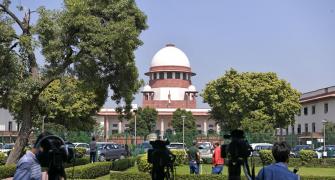It is certainly good news for Indian planters who are facing severe shortage of suitable land for expanding rubber cultivation.
What is heartening is that Cambodia's wounds are healing fast. Certainly not by miracles, but by the solid resolve of the present regime and the optimism of the wounded populace of the country who are trying to recover from the trauma of the worst ever massacres that took place under the infamous Khmer rouge regime headed by Pol Pot in the 70s.
Today Cambodia is striving hard to be among the most happening Asian countries pinning its hopes on the high potential agriculture sector of the country blessed with vast stretches of fertile soil, enough water, copious rains and an enterprising young generation.
Rubber tops the priority list of the government, obviously because of the fact that the red soil of Cambodia is ideal for growing rubber, which has been witnessing an unabated boom in recent years. Moreover the country's close proximity to China, which has recently emerged as the world's largest consumer of rubber replacing the US seems to be the driving factor for the government's hard selling efforts focused on rubber.
Not surprisingly, the historic Cambodian capital of Phnom Penh played host to the 4th ASEAN Rubber Conference, one of the world's major rubber events last month. There was a significant Indian presence at the conference attended by over 450 delegates from across the globe.
The Rubber Board chairman himself was present at the conference and has chaired the session on "An overview of the World NR and SR position".
What makes Cambodia attractive for Indian investors in rubber?
The highly fertile red soil ideal for rubber plantation
Sumptuous rains and water resources
The country is characterized by a low level of rubber diseases
The comparatively cheap labour available in the country
The government incentives to promote rubber
Proximity to China which today is the world's largest consumer of rubber
Easy air access via Singapore (Only two hours air travel from Singapore)
Rubber plantation industry of India, which currently is the 4th largest producer of natural rubber in the world is currently reeling under severe shortage of skilled tappers and facing constraints in area expansion. In fact a large extent of area identified as suitable for cultivating rubber in non traditional region is classified as forest land and forest Conservation Act does not allow cultivating rubber in forest land because rubber is not classified as forest crop in India.
The traditional rubber-growing region is already saturated. India also has constraints in cost reduction because the agro-climatic conditions are only approximately favourable, which necessitates additional cost for spraying fungicides. Indian plantations are dominated by tiny holdings of about 0.50 hectares size, which is disadvantageous in terms of economies of scale. Undulating land terrain in major rubber growing regions necessitates additional cost for soil conservation measures.
It is against this backdrop, India can think of responding to the Cambodian call. India has enviable traditional expertise in rubber and has the best breeds of rubber clones developed by the Rubber Research Institute of India. Indian planters can very well exploit the opportunities offered by Cambodia. It may be noted that already countries like Vietnam and China are into Cambodian rubber sector in their bid to tap the current NR boom to the maximum. The NR prices are projected to rule higher at least for the next 10 to 15 years as the demand is growing against a tight supply situation.
The government of Cambodia has already launched the first phase of its divestment plan relating to the state owned rubber estates and tenders in respect of three of the total seven estates are scheduled to close later this month. These three plantations located on the rubber rich Kampong Cham province have a total area of 23,402 hectares. The International consultancy agency SOFRECO has been engaged as advisors for the divestment plan. Along with this, the government is going ahead with its plans to lease out its cultivable area conducive to rubber for foreign investors on a 99-year lease.
The projection is that the area under rubber in Cambodia will go up to 94,000 hectares in 2010 from 66,000 tonnes in 2004. The figures are expected to touch 124,000 hectares and 150,000 hectares respectively in 2020 and 2030. An official spokesman of the Cambodian rubber industry speaking at the ASEAN rubber conference expressed the hope that Cambodia would emerge as one of the top players in global rubber by 2015 or 2020.
Rubber industry plays an important role in the socio economic development of the country. The latest plans of the government to rejuvenate this industry are also aimed at creating jobs and generating income for the farmers who are mostly poor.
Rubber plantation in the country dates back to 1910 when a Frenchman Mr Bouillard planted rubber across 150 acres. At present the country is one of the 23 rubber producing countries of the world. The size of the rubber plantations is still small covering an area of 70,000 hectares as against a total available area 350,000 hectares highly conducive for rubber, thanks to the highly fertile red or basal soil. For the last ten years, the state rubber owned plantations have covered about 80% of the total plantation areas and the rest is owned by private sector. Long term forecasts says the country's NR production will touch 100,000 tonnes a year by 2020.
Yes, immense opportunities await rubber investors in Cambodia. The very fact that the ASEAN rubber conference at Phnom Penh registered an attendance of nearly 450 delegates from across the globe is indicative of the global interest in Cambodia's high potential rubber sector. Let us hope that the Indian planters will take up the Cambodian Challenge in right earnest and before it is too late.
Cambodia's Rubber Profile
Rubber production represents 4% for the agricultural industry's GDP (which itself represents 33% of national GDP)
The value of rubber exports stood at 83 million USD in 2004 representing 4% of the total national exports.
The rubber industry provides jobs to 27000 persons directly and 40,000 indirectly.
Rubber has an export tax rate of 10% of the sales value.
The export tax revenue is ploughed back for the industry's development.
Problems of Cambodian Rubber Sector
Low production
Quality issues
Poor R & D
Lack of training programmes
Lack of sufficient processing facilities
Lack of down stream rubber industries







